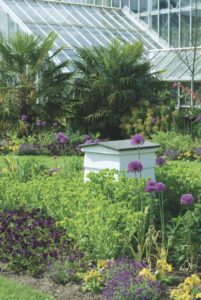In this ode to the bee, Cambridge University Botanic Garden’s head of horticulture Sally Petitt helps us create the perfect garden for these precious pollinators
Gardens are not only beautiful places offering peace, tranquillity and inspiration to gardeners and visitors, but they also support a wide range of wildlife. For bees, gardens are invaluable in providing nectar for energy, protein from pollen to feed their larvae and, for some species, shelter.

The Botanic Garden’s Bee Borders are a haven for bees throughout the foraging season. Image by Joe Higham
In the UK, we have more than 250 species of bee, but their numbers have been declining due to factors such as habitat loss, pollution, pesticide use and climate change, as well as pests and diseases, including the parasitic varroa mite that attacks and kills honey bees.
So, what bee-friendly plants can we grow to support these essential pollinators? The good news is that there is a variety of plants we can grow to attract bees. Whether in your own garden or out for a walk, it’s easy to spot which flowers are most effective at luring them in and rewarding them with pollen and nectar.
What’s fascinating is that many of these plants have developed features to help bees pollinate their flowers. As one example, foxgloves have a landing platform and nectar guides – visual markings that guide bees to the pollen and nectar in the throat of the flower. Other plants, such as sunflowers, guide by ultraviolet patterns in their petals that are visible to bees but not to humans.
Bees are also unable to see the colour red, and are mainly attracted to purple, pink and blue flowers. Interestingly, single flowers are more effective at attracting pollinating bees than double flowers, which hinder access to nectar and pollen.
Planting for all-year-round interest
While it’s tempting to think of bees only during summer, they will forage for food in all seasons, and gardeners can create a display of bee-friendly flowers throughout the year.

Sally Petitt is head of horticulture at Cambridge University Botanic Garden. Image by Howard Rice
During the winter months, bees will eagerly seek out plants such as snowdrops, Oregon grape and winter honeysuckle. As spring arrives, bulbs such as tulips, flowering cherries and herbaceous perennials like cowslip and lungwort provide welcome food for bees. Summer will bring a wealth of bee-friendly plants including rosemary, foxglove, globe thistle and honeysuckle. Autumn favourites such as sedum, asters and single dahlias offer invaluable food sources, along with the native ivy, whose autumn flowers are often amassed with bees.
While we may take the humble bee for granted, there’s every reason to encourage them to visit our gardens, and even the smallest plot can support a few bee-friendly flowers. Here at Cambridge University Botanic Garden, our Bee Borders are designed to provide year-long interest and inspiration for visitors, gardeners and bees alike – creating a real bee magnet!

The bright colours of flowers, especially purple, pink and blue, stand out to bees. Image by Howard Rice
With careful plant selection, traditional-style herbaceous and mixed borders offer a perfect opportunity to attract bees to your garden. For a relaxed garden style, bee-friendly annual mixes are ideal and can easily be sown directly into your garden to encourage bees to your patch. And if you’re keen to attract bees in a wildlife-friendly garden, many native wildflowers such as white nettle, primrose and hawthorn are favourites.
You could also add features such as a bee hotel to provide shelter for solitary bees, and a shallow bee water station so they can feed their young and help keep their hive cool and humid in summer.
For humans, the work of bees is critical, ensuring the production of crops we rely on. Without them, there would be no apples, tomatoes, sweetcorn or even chocolate. In short, humans need bees to survive. Anything we can do as gardeners to bolster bee populations can only be a good thing, not only for bees but for our fragile ecosystem – and us as humans.
So, while pottering in your patch, spare a moment to watch these productive insects – you’ll quickly be mesmerised by them going about their essential work!
Top tips for attracting bees to your garden
- Select plants to provide flowers year-round.
- Bees are most attracted to purple, blue and pink flowers, though will pollinate other coloured flowers too.
- Consider adding a bee hotel and bee water station.
- Avoid using chemicals that are harmful to bees.
Gardening jobs for May
- Keep on top of weeds.
- Thoroughly water new plantings to establish strong roots.
- Sow seeds of tender vegetables such as beans, sweetcorn and courgettes under cover, ready for planting out once the risk of frost has passed.

